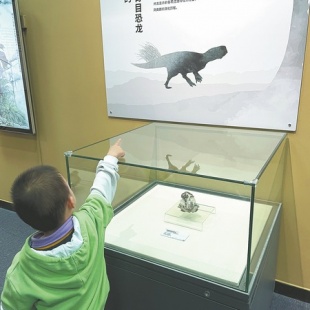Exhibition casts light on link between past and present


About 130 million to 110 million years ago, a vast region — covering today's western Liaoning province, southern Inner Mongolia autonomous region and northern Hebei province — had a warm climate and a landscape of lakes and forests, which nurtured the many and diverse plants and animals, nowadays known as the Jehol Biota.
Scientists have proposed that repeated volcanic eruptions might have killed the creatures and created the fossil trove that even preserves soft tissue, like skin, organs, feathers and fur, in the ancient lake rock layers. Dubbed the "Mesozoic Pompeii" for its similarity to the ancient Roman city destroyed by the violent eruption of Mount Vesuvius in 79 AD, the Jehol Biota has provided tantalizing clues to evolutionary studies.
Ancient Jehol: Special Exhibition on Major Mesozoic Fossil Discoveries at the National Natural History Museum of China in Beijing tries to take visitors back to the period to better understand the link between the past and today, through 131 exceptional fossils unearthed over the past three decades. Opened on Nov 2 and running through Dec 3, the exhibition is organized by the museum and the Lingyuan city government in Liaoning.
"Over the past 30 years, Chinese researchers have studied the biota, with some world-influential discoveries published in scholarly journals," Zhang Yuguang, deputy director of the museum, says.
"The exhibition showcases these findings through vivid language and multimedia presentation."
He adds that more than half of the fossils are on display for the first time, and 130 are type specimens designated as a permanent reference for a new species.
Deng Tao, head of the Institute of Vertebrate Paleontology and Paleoanthropology of the Chinese Academy of Sciences, agrees that the exhibition is a platform to showcase these important discoveries by Chinese scientists, some of which might even change published texts.





































